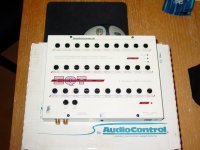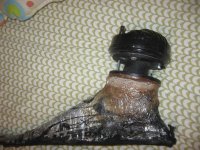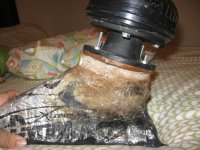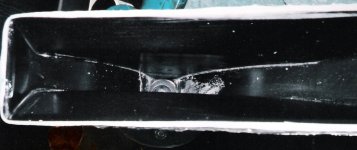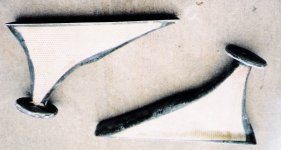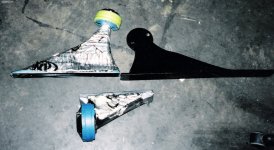Sure sounds familiar to me.
Absolutely!
I was definitely inspired by your Summas
The thing that's enlightening about my experiments is that the three things mentioned in the previous post seem to be as important (if not more than) the shape of the horn itself.
Everyone seems to obsess about the shape of the horn, when those three things seem to matter a great deal also.
For instance, the majority of commercial loudspeakers don't have any diffraction treatment whatsoever. The roundover seems to make an extraordinary difference.
- The off axis response of the treated device is better than the off axis response of the untreated device. This reinforces the theory that a significant fraction of the energy produced by the untreated horn is being generated by waves which are not traveling down the axis of the horn.
- I have treated oblate spheroidal waveguides with foam, and they experience a modest reduction in SPL. About 3db above 10khz, decaying to about 1db at 1khz. This horn, with a diffraction slot, is seeing a much greater reduction in SPL, with a foam plug which is smaller. My theory is that there are more HOMs in this diffraction horn than in an OS waveguide, and the foam is attenuating them.
I could be wrong, but I don't think that this is correct.
I think the reason for the treble loss is due to greater high freq. absorption from the foam relative to the OS design. (..Horn with a longer path length, less expansion, etc..) Furthermore, I'd expect it to have *less* effect lower in freq., exaggerating the upper freq. loss relative to the average. Diffraction throat or not, its a horn.
Anyway, whether either of us is correct or not, an excellent thread with good results!
The thing that's enlightening about my experiments is that the three things mentioned in the previous post seem to be as important (if not more than) the shape of the horn itself.
Everyone seems to obsess about the shape of the horn, when those three things seem to matter a great deal also.
I hate to admit it but this is entirely correct. I have kept kind of mum about this realization (which I made quite awhile ago - it doesn't play well into my position) but its absolutely correct. More correct than I think that you would even guess. Its not good for business to give away all ones secrets, but there is more to all this than meets the eye. By hook or crook you are catching up to what I've found over the last six years of development. There are still some things that are hidden in the cracks, but you'll probably figure those out.
I mean "cut-off frequency" and "loading" -- who cares!!
Absolutely!
The thing that's enlightening about my experiments is that the three things mentioned in the previous post seem to be as important (if not more than) the shape of the horn itself.
Everyone seems to obsess about the shape of the horn, when those three things seem to matter a great deal also.
For instance, the majority of commercial loudspeakers don't have any diffraction treatment whatsoever. The roundover seems to make an extraordinary difference.
..And this conclusion is rather different than what Earl has been stating.
1. The dispersion pattern for instance isn't exactly the same as what an OS contour provides.
2. Neither is minimizing throat diffraction represented here.
Again, the emphasis is virtually all on the "mouth" (..which is far more representative of Jean-Michel's position.)
This begs a natural question: Have you had the opportunity to try a Le Cleac'h contour with a maximum round over for comparison? (..I know, ..absolutely worthless in a car environment.
Last edited:
I hate to admit it but this is entirely correct. I have kept kind of mum about this realization (which I made quite awhile ago - it doesn't play well into my position) but its absolutely correct. More correct than I think that you would even guess. Its not good for business to give away all ones secrets, but there is more to all this than meets the eye. By hook or crook you are catching up to what I've found over the last six years of development. There are still some things that are hidden in the cracks, but you'll probably figure those out.
I mean "cut-off frequency" and "loading" -- who cares!!
Well these aren't Summas by any means. I'm listening to my Summas as I type this, and I've been listening to them since 5am this morning. I'd love to see someone listen to a horn for fourteen hours straight without crying "uncle."
Having said that, the foam and the roundover makes a measurable and breathtaking difference. It's interesting that people have been using EQs to tame horns for decades, when this seems to work a lot better, *and* it's cheaper.
..And this conclusion is rather different than what Earl has been stating.
1. The dispersion pattern for instance isn't exactly the same as what an OS contour provides.
2. Neither is minimizing throat diffraction represented here.
Again, the emphasis is virtually all on the "mouth" (..which is far more representative of Jean-Michel's position.)
This begs a natural question: Have you had the opportunity to try a Le Cleac'h contour with a maximum round over for comparison? (..I know, ..absolutely worthless in a car environment.)
No, but I'm open minded! If there's one in the states, point me in the right direction. If you want to hear some Summas, or my car, I intend to demo both this month at the PNW Audio Society.
What's really piqued my curiosity is the extraordinary improvement rendered to a rather mediocre horn. Look at this response above 2khz; it's ridiculously smooth, considering the horn is easily eight times too small, preposterously asymmetrical, and has a diffraction throat. Even the compression driver is beat up.
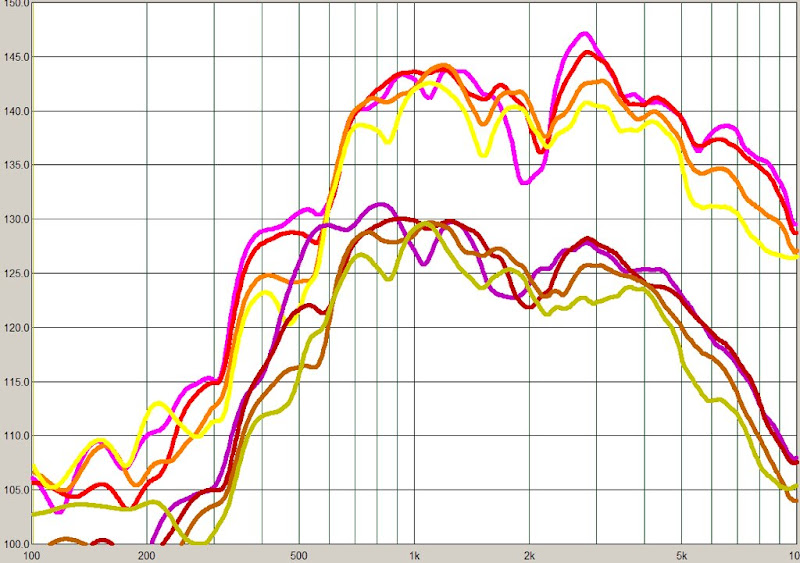
It really makes me wonder what you could get away with if you used an elliptical mouth and a 360 degree roundover. I have a feeling it would measure quite well.
It really makes me wonder what you could get away with if you used an elliptical mouth and a 360 degree roundover. I have a feeling it would measure quite well.
I think you would be correct, AND it should give somewhat better low freq. extension. But it isn't well suited to a baffle, nor as a result a more common loudspeaker shape.
IMO though, the first thing you should do is decide what type of dispersion pattern you actually prefer.
In other words, is the OS's nearly "flat"/conical (diffraction free) throat profile with attendant uniform dispersion loss really the pattern that "works" for you? Or would you prefer increased horizontal dispersion, (..from a far better contour than the test here), with the typically resulting non-uniform loss in pressure vertically? Or perhaps you would prefer the narrowing/directivity loss in pressure at higher freq.s that the (Std.) Le Cleac'h profile provides? Lots of choices here, but like you - I think you have the most important element figured out.
Last edited:
It's interesting that people have been using EQs to tame horns for decades, when this seems to work a lot better, *and* it's cheaper.
Just curious but where in the frequency range?? Are you talking passive EQ for CD or EQ an in an equalizer??
Rob
No, but I'm open minded! If there's one in the states, point me in the right direction.
Brandon's?
Really, I've seen precious little state-side (..and all where the air is thin.)
Yeah, I know.. useless.
So, how do you feel about that *131st* DIY horn?
 (..please, try not to throw the only partially depleted beer cans at me.)
(..please, try not to throw the only partially depleted beer cans at me.) Just curious but where in the frequency range?? Are you talking passive EQ for CD or EQ an in an equalizer??
Rob
In the car audio world there's a lot of reverence for "old skool" setups, and a lot of people are copying what worked in the 80s. Myself included, honestly.
In the 80s a standard setup was a set of horn-loaded compression drivers, driven by a good solid state amp, with a pair of 31 band EQs to tame the horns. These were ubiquitous:
An externally hosted image should be here but it was not working when we last tested it.
If I'm not mistaken, USD, Image Dynamics and Crossfire were basically re-badging Rane EQs. I could be wrong, maybe Winslow will chime in.
The EQ can tame the horns to an extent, but the foam and the roundover is far more satisfying. Subjectively, the combination of horn and equalizer is satisfying in the short term, but grows fatiguing quickly. In this respect, it's almost perfect for winning sound off competitions, because when you first hear a good set of horns, it's a life-changing experience.
The problem is that they begin to grate on your ears. Slowly, but surely.
The foam and diffraction treatments make the horns sound like a good direct radiator, albeit a very efficient one, instead of a conventional horn.
It would be great to see a company like Image Dynamics license this technology.
The ID EQs were not Rane. USD were Rane. Don't know about Crossfire. I'm using a converted Rane RPM88 in my car for all of my processing needs.
Eric at ID does have a copy of Dr. Geddes's book. I am supposed to have sent him some foam a few months back. I need to do that.
Interesting results. I have been trying to scheme a way to make a curve for the bottom of the horn to the floor for critical listening and judging. The problem I am having would be it would completely obscure the midbasses in the floors. Might give this treatment a go when I get the horns installed in the new car.
Eric at ID does have a copy of Dr. Geddes's book. I am supposed to have sent him some foam a few months back. I need to do that.
Interesting results. I have been trying to scheme a way to make a curve for the bottom of the horn to the floor for critical listening and judging. The problem I am having would be it would completely obscure the midbasses in the floors. Might give this treatment a go when I get the horns installed in the new car.
The ID EQs were not Rane. USD were Rane. Don't know about Crossfire. I'm using a converted Rane RPM88 in my car for all of my processing needs.
Eric at ID does have a copy of Dr. Geddes's book. I am supposed to have sent him some foam a few months back. I need to do that.
Interesting results. I have been trying to scheme a way to make a curve for the bottom of the horn to the floor for critical listening and judging. The problem I am having would be it would completely obscure the midbasses in the floors. Might give this treatment a go when I get the horns installed in the new car.
A horn or waveguide that's fourteen inches wide will lose directivity control around 1khz. The USD horns are a bit wider than that, but they're far, FAR too short to work properly.
Or at least, that's what the theory tells us.
But if you look at the measurements again, you can see that the treated horn has quite remarkable polar response down to 2khz. It gets a bit wonky after that, but all things considered, these are excellent plots.
Of course, we can't even get a proper anechoic measurement, because these horns depend on the car itself to bring up the low end. My measurements are gated. IIRC, it's 12ms long, to capture three wavelengths at 250hz. In a room they wouldn't go this low.

Dare I say it, I think the curve you mentioned would be overkill. Just add some foam, a roundover, and be done with it.
What compression driver are you using? I believe the USD uses a Radian 450PB, which can't play much below 1khz.
Yeah, probably will do the roundover. Tried the foam already.
At first I modded the horns to work with BMS 4591s and was going to use a Fane ST5022 on the top end. But I got a smoking deal on some Beyma CP755nDs from Duke. So I got some 1.4" to 2" adapters and put them on the horn so I can use the Beymas.
I have to mention my ID horns are straight entry horns. The adapter I think made the horns sound better. Why? Because the first 1.5" is round vs. normally angular. Though it is an exponential adapter I think it helped. I want to eventually make an OS adapter. I know these horns are diffraction slots, but I figure the first couple of inches are very crucial for HOM and diffraction artifact development.
Was that too rambling? Have a 3 month old little girl that has me zapped already...lol.
At first I modded the horns to work with BMS 4591s and was going to use a Fane ST5022 on the top end. But I got a smoking deal on some Beyma CP755nDs from Duke. So I got some 1.4" to 2" adapters and put them on the horn so I can use the Beymas.
I have to mention my ID horns are straight entry horns. The adapter I think made the horns sound better. Why? Because the first 1.5" is round vs. normally angular. Though it is an exponential adapter I think it helped. I want to eventually make an OS adapter. I know these horns are diffraction slots, but I figure the first couple of inches are very crucial for HOM and diffraction artifact development.
Was that too rambling? Have a 3 month old little girl that has me zapped already...lol.
I figure the first couple of inches are very crucial for HOM and diffraction artifact development.
This has been debated extensively and I don't think that there are any conclusions. Its not clear that its true although it does appear to be logical. But "logical" is not proof of fact, and, in fact, in acoustics, its often misleading.
Hi Winslow
Good application of constrained layer dampening!
I notice the Dynamat layered over with fiber glass cloth. I kind of thought that applied on the exterior of the horn it may work to dampen the resonances. I'm guessing as a slightly viscous layer in between two rigid layers it would really dampen well. Does it work well?
I personally use what is called ice and water shield up here. ( not much use for ice shield in California ) It is used for the first layer on roofing underneath the shingles. It is pretty much the same as Dynamat but has aggregate loading on one side like standard shingles and the most unforgiving sticky glued side on the other. It is not cheap but $85 will get you 3 feet by 60 feet.
Mark
Good application of constrained layer dampening!
I notice the Dynamat layered over with fiber glass cloth. I kind of thought that applied on the exterior of the horn it may work to dampen the resonances. I'm guessing as a slightly viscous layer in between two rigid layers it would really dampen well. Does it work well?
I personally use what is called ice and water shield up here. ( not much use for ice shield in California ) It is used for the first layer on roofing underneath the shingles. It is pretty much the same as Dynamat but has aggregate loading on one side like standard shingles and the most unforgiving sticky glued side on the other. It is not cheap but $85 will get you 3 feet by 60 feet.
Mark
The production horn bodies are urethane and could use a layer or two of damping materials to help tame body resonances. These particular horn bodies are fiberglass as they were custom made for me by Image Dynamics to be a straight entry horn rather than having the driver enter at an angle.
But the plan was to use a 2" compression driver and a super tweeter...so I could play the horns really low. So, knowing the flare rate of the horn I found the area progression where the flare went to a 2" entrance. Then I cut the horns there. The glass was used to hold a new 2" mounting flange. I just spread the chopped fiber until it was smooth and even from the cut part ..like icing a cake. There really wasn't a plan to do any additional damping via the glass...but I guess it worked to some degree. The most resonant part is the mouth, the shape and need for thinner material makes it ring some- though nowhere near as bad as the aluminum bodies from Veritas did.
So, I scrapped the idea of the 2" driver and got a smoking deal on the 1.4" Beymas and rolled with them on adapters. The Beymas sound really really good. Hopefully once I get them in the car I will have them crossed a little below 500 hertz on a 72 dB/octave slope.
But the plan was to use a 2" compression driver and a super tweeter...so I could play the horns really low. So, knowing the flare rate of the horn I found the area progression where the flare went to a 2" entrance. Then I cut the horns there. The glass was used to hold a new 2" mounting flange. I just spread the chopped fiber until it was smooth and even from the cut part ..like icing a cake. There really wasn't a plan to do any additional damping via the glass...but I guess it worked to some degree. The most resonant part is the mouth, the shape and need for thinner material makes it ring some- though nowhere near as bad as the aluminum bodies from Veritas did.
So, I scrapped the idea of the 2" driver and got a smoking deal on the 1.4" Beymas and rolled with them on adapters. The Beymas sound really really good. Hopefully once I get them in the car I will have them crossed a little below 500 hertz on a 72 dB/octave slope.
Attachments
Here's my straight entry ID horns with the large format drivers on adapters.
Excuse the grill cloth coming off of the edges.
In my current project I've turned the waveguides on the dash into Unities, extending their response about an octave and a half. Prior to the Unity treatment they played to about 1khz; with the Unity midranges they're going well below 500hz.
Without a doubt, my favorite part about the unities is their intelligibility. There is something about getting the entire midrange on a single waveguide that's breathtaking. For instance, when I listen to a song on the Unities where two singers are harmonizing, the Unity is able to delineate the two singers in the mix with ease, whereas conventional speakers do not.
The reason that I bring this up is that I think part of the unity magic has to do with covering the whole midrange on a single waveguide or horn. You would think that a full range could pull of the same trick, but it doesn't. They don't have the same clarity as a Unity. I think this is because early reflections are reduced by the waveguide or horn.
My Summas at home sound similar, but you need to sit at least two meters back. I'm guessing this is due to the center-to-center spacing of fifteen inches.
Anyways, long story short, I'll bet the Beymas will sound particularly good in the nearfield.
- Home
- Loudspeakers
- Multi-Way
- The HOMster! (or How I Learned How to Fix a Horn)
